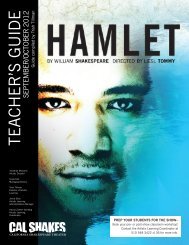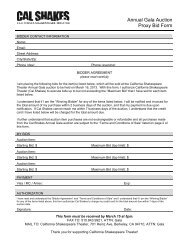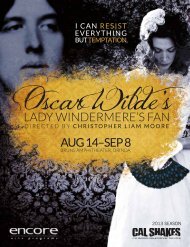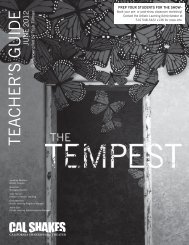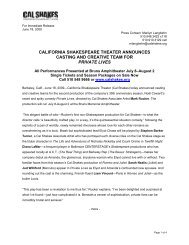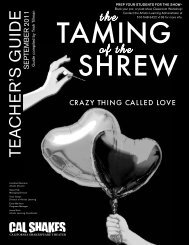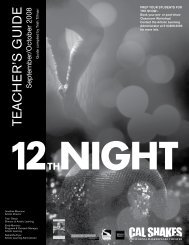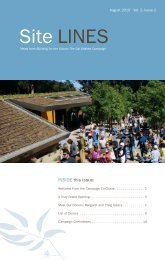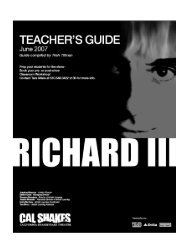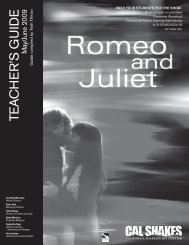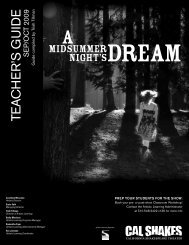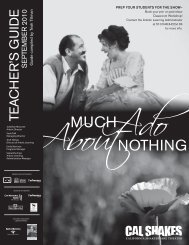WHO'S WHO - California Shakespeare Theater
WHO'S WHO - California Shakespeare Theater
WHO'S WHO - California Shakespeare Theater
Create successful ePaper yourself
Turn your PDF publications into a flip-book with our unique Google optimized e-Paper software.
THIS REMARKABLE PERFORMANCE TROUPE<br />
MASHES TOGETHER HISTORY, POLITICS, MUSIC,<br />
AND COMEDY TO GIVE VOICE AND EXPRESSION<br />
TO CONTEMPORARY TIMES AND PLACES.<br />
CULTURE<br />
C L ASH:<br />
RIDING WILD FOR 30 YEARS<br />
BY RESIDENT DRAMATURG PHILIPPA KELLY<br />
Border crossers carry memories—<br />
scents, tastes, conversations, moments<br />
of peace, personal histories—that serve<br />
as tools for adjustment, helping them<br />
to create a sense of home in a new<br />
country. Yet for Chicanos in <strong>California</strong>,<br />
America is not really a new country,<br />
given that Mexico once controlled much<br />
of what is now the United States, in<br />
parts of <strong>California</strong>, Texas and elsewhere.<br />
Before being granted the right to<br />
cross into this land, however, Mexicans<br />
must be inspected and validated at the<br />
border. This border, both real and metaphorical,<br />
marks the recent history of<br />
contemporary culture, in which barriers<br />
separate citizens from so-called aliens:<br />
Border controls represent not just the<br />
law, but the gaps and breakdowns—the<br />
places of alienation, failures of<br />
communication—between traditions,<br />
histories, and cultures.<br />
All the way back to the ancient Greeks,<br />
theater has offered a crucial means of<br />
recognizing and addressing such gaps<br />
and failures. Sadly, however, art works<br />
motivated by recuperative ideology too<br />
often veer into tiresome didacticism.<br />
Not so with Culture Clash, a theater<br />
group that veers right away from<br />
didacticism, mixing political material<br />
with slapstick, rap, and a myriad and<br />
mixture of languages in order to startle<br />
and amuse, to provoke self-reflection<br />
and even self-censure.<br />
“Hopefully we are making audiences<br />
laugh and think,” says Richard Montoya,<br />
founding member of Culture Clash<br />
and author of American Night: The<br />
Ballad of Juan José.<br />
“Guys like Aristophanes, and other<br />
Greek comics…they were extremely<br />
bold, and, towards the end of their<br />
civilization, were able to incorporate the<br />
use of comedy in poking fun at the establishment<br />
and well-entrenched men<br />
like Plato. They were very satirical and<br />
raunchy…. And as a troupe we [Culture<br />
Clash] were all able to connect to and<br />
relate to all of that.”<br />
Thinking back on the inspiration for<br />
Culture Clash some 30 years ago, Montoya<br />
remarks on the company’s mixture<br />
of politically sharp sketch comedy and<br />
“slapstick-erudite sociology”: When<br />
the group eventually to be known as<br />
Culture Clash emerged at René Yáñez’s<br />
Galeria de la Raza in San Francisco<br />
on Cinco de Mayo 1984, they arrived<br />
at the tail end of a movement of<br />
serious-minded Chicano theater that<br />
had formed in concert with political<br />
agitation by Chicano communities in<br />
the 1960s. While by that time in the<br />
southwest alone there were some 70<br />
Latino (Spanish-speaking American,<br />
as distinct from Mexican-American)<br />
theater companies, not many included<br />
comedians. Inspired by the Chicano<br />
political theater of Teatro Campesino<br />
and the circus traditions of Mexico and<br />
Central America, the newly formed<br />
group—then six persons strong—felt<br />
that Chicano theater and performance<br />
art needed an injection of comedy.<br />
Drawing on mainstream comic<br />
influences such as Lenny Bruce,<br />
Richard Pryor, the Marx Brothers, and<br />
even Charlie Chaplin, they made a<br />
point of being silly and political at the<br />
same time.<br />
Montoya recollects that while he and<br />
his co-founders thought they were<br />
making theater for Latinos, they found<br />
that much of their audience was “predominately<br />
Anglo … or an NPR type of<br />
audience who thought along the same<br />
lines that we did.” Audiences leapt at<br />
the mixture of slapstick, vaudeville,<br />
mime, spoken-word, and acting that<br />
displayed loudly, and with laughter,<br />
the dignity, strength, complexities and<br />
dysfunctions of oppressed people in the<br />
United States.<br />
Originally called “Comedy Fiesta,”<br />
Culture Clash first did cabaret-style<br />
shows and sketch comedy, with no<br />
story through-lines. Within a few years<br />
the group shrank to its three current<br />
members (Richard Montoya, Ricardo<br />
Salinas, and Herbert Siguenza),<br />
adopting the name Culture Clash as<br />
an inspiration from two very different<br />
’80s English bands, Culture Club<br />
and the Clash. The name also refers<br />
to the culture clash of Latinos and<br />
other Americans, as well as the clash<br />
between different Latino groups in<br />
American society. In 1998, Culture<br />
Clash premiered The Mission, in which<br />
three out-of-work performers from the<br />
Mission District kidnap Julio Iglesias<br />
to get exposure for their act, calling it<br />
their “break into legitimate theater.” It<br />
precluded a long line of what the group<br />
calls “mongrel theater forms,” designed<br />
to exploit and explore the relationship<br />
between theater, with its long history,<br />
and the world in which we live—as<br />
with their show, Peace, which brought<br />
the revolutionary spirit of Aristophanes<br />
(who wrote in 421 BC) to contemporary<br />
America . In 2009 Culture Clash<br />
banded with LA’s Cornerstone <strong>Theater</strong><br />
Photos by John Maldonado, courtesy of Culture Clash.<br />
to transform the Getty mansion into the<br />
palace of Zeus, God of War, who had<br />
imprisoned the goddess, Peace. In their<br />
self-appointed mission to rescue Peace<br />
and restore her to the land, the boys of<br />
Culture Clash fired off oblique and ribald<br />
social commentary about America’s<br />
engine of war.<br />
Through performance collage, Culture<br />
Clash brings together history, geography,<br />
poetry, and music in a contemporary,<br />
movable theater narrative from<br />
Chicano points of view: what Chicano<br />
performance artist/writer Guillermo<br />
Gómez-Peña describes as a kind of<br />
“reverse anthropology.” Anthropology<br />
has conventionally been seen as a<br />
study of other cultures; it presumes the<br />
western mainstream to be a transparently<br />
shared norm. But what if<br />
we overturn the traditional hierarchy<br />
between anthropologist and traditional<br />
subject? Suddenly the mainstream is<br />
reimagined, or relocated, through the<br />
jokes, the colloquialisms, the preoccupations,<br />
and the parodies of a culture<br />
that organizes and prioritizes knowledge<br />
in different and culturally specific ways.<br />
In the interests of such challenges,<br />
Culture Clash has been commissioned<br />
by theater companies in Miami, San<br />
Diego, New York, Houston, Boston, and<br />
San Francisco to create performance<br />
pieces specifically for those cities. “Male<br />
and female, gay and straight.<br />
Accents with a touch of Yiddish, of<br />
Iowa, or Guatemala. Muslim and Jews,”<br />
says journalist Hector Tobar, “these guys<br />
will work themselves into any skin.” Into<br />
any medium, as well, it seems—witness<br />
the docu-comedy they made entitled<br />
In Search of Aztlan, as well as the 30<br />
sketch comedy episodes that aired on<br />
Fox-TV, entitled simply Culture Clash.<br />
This remarkable performance troupe<br />
mashes together history, politics, music,<br />
and comedy to give voice and expression<br />
to contemporary times and places,<br />
making audiences laugh at, and question,<br />
their own values, stereotypes, and<br />
lunacies, landing blows to the Left as<br />
well as to the Right.<br />
Continued on page 29.



